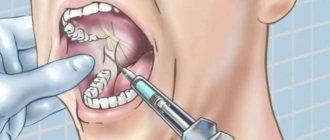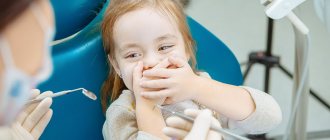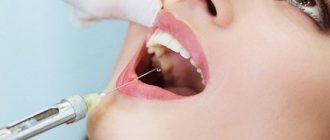- Operating principles
- Anesthesia methods
- Indications and contraindications
- Types of anesthesia
- pain relief in pregnant women
- Anesthesia for children
- Recommendations
- Complications
- Drugs used
- Price
Nowadays, it is possible to receive medical care not only fast and high-quality, but also painless. Almost any action of the doctor that can bring discomfort or unpleasant sensations to the patient is accompanied by dental anesthesia, or in other words, “freezing”. He stops experiencing pain and fear and relaxes, allowing the dentist to calmly do his job.
Operating principles
Anesthesia is carried out immediately before the start of treatment. The anesthetic comes in both liquid and gel form. The doctor injects into the soft tissues that are located near the diseased tooth. After some time, the tongue, gums and cheeks become numb and “freeze”. At this moment, the anesthetic acts as a blocker of nerve impulses that send a pain signal to the brain. The patient calmly endures dental procedures without experiencing stress.
The duration and effectiveness of dental anesthesia depends on the quality of the materials used and the location of the injection. The closer to the problem area the injection was administered, the more intense its effect. Each organism is individual, therefore the drug will be excreted at different rates.
Different types of drugs function in their own ways. For example, gel-like ones applied to the gums or surface of the cheek last only a couple of minutes. If they are installed in the upper part of the jaw, the effect will last for 2-3 hours. To treat the lower group of teeth, a deeper injection is required, so the result lasts up to 4 hours. After the solution is absorbed, the numbness disappears and sensitivity returns to the patient.
Our advantages
Our dentistry treats dental caries in Moscow (Ramenki district) at affordable prices. We cooperate directly with many manufacturers of dental materials, avoiding intermediaries. This allows us to provide you with genuine European quality without putting an extra strain on your budget. Polite and helpful staff, comfort and convenience are at your service. Come visit us and appreciate the advantages of the center [email protected] :
Quality of treatment
- Personality. Professional approach to each individual case.
- Subsequence. Medical procedures are carried out only after a full diagnostic examination and agreement on the treatment plan and cost. If necessary, specialists from related fields (periodontist, surgeon, implantologist, orthopedist, orthodontist) will be invited to a consultation. The price of dental treatment depends on the stage of development of caries. The sooner you contact your dentist, the easier and cheaper it will be to get rid of the problem.
- Qualification. The appointment is conducted by an experienced specialist who is fluent in modern and classical techniques in the field of endodontic, therapeutic, and aesthetic dentistry.
- Certificates. We work only with certified drugs. Three-dimensional obturation with liquid gutta-percha (work in the canals). For direct restoration of a damaged crown, innovative nanocomposite filling materials from leading brands (USA, Europe, Japan) are used.
- Guarantee for all types of work.
Safety
- Multi-stage disinfection and sterilization of instruments and apparatus.
- Disposable instruments.
- Painless. Computer anesthesia STA is the most comfortable treatment of caries in dentistry. Reduced dosage of anesthetic (without compromising the effectiveness of anesthesia), absence of unpleasant sensations after the drug has stopped working.
Technologies
- Diagnostic examination using a digital orthopantomograph Planmeca ProOne.
- Application of optical caries detector, laser.
- Treatment of dental caries under a microscope. The most precise passage of channels, complete mechanical and medicinal treatment, without the risk of complications.
- Ceramic inlays for restoring a damaged tooth – inlay, onlay (indirect restoration).
Anesthesia methods
Depending on the goals and nature of the problem, the doctor chooses the method of pain relief. In medicine there are two main methods:
Anesthesia
It is most often used in surgery, and in dentistry much less often, in case of urgent need. It affects the entire body of the patient, inducing a state of sleep. At this time, all muscles relax and consciousness turns off. You can administer painkillers intravenously or inhale vapors through a mask. Deep anesthesia is used during complex operations when a person does not have enough strength to cope with pain or it is necessary to completely eliminate body movement. During sleep, the doctor monitors the patient's condition to avoid emergency situations.
Recovery from anesthesia is the body’s return to normal functioning after a long “freeze.” For all people, this process proceeds differently, some experience signs of nausea or a feeling of lethargy, while others wake up well-slept and rested.
General anesthesia in dentistry during pregnancy is applicable only in emergency cases when there is no other alternative.
Local anesthesia
Unlike anesthesia, it occurs locally, affecting only certain areas of the body. Can be used for children and pregnant women, without fear of unwanted consequences. In dental practice, this method is most often used, so we will talk about it in more detail.
General anesthesia in dentistry
With general anesthesia, the patient falls asleep for 1-2 hours or more, i.e. for the entire duration of treatment. The drug is administered intravenously, less often by inhalation. If possible, general anesthesia should still be avoided, since its effect on many organs is quite toxic. Even despite the fact that dentistry uses “lighter” drugs than during complex surgical operations. This is a fairly large load on the body, especially on the heart, nervous and cardiovascular systems.
Indications and contraindications for the use of local anesthesia
Any dental intervention that causes pain must be accompanied by “freezing” of the required area of the oral cavity. There is a list of diseases for the treatment of which it is necessary to administer anesthetic drugs:
- Complex caries;
- Removal of a tooth or its roots;
- Periodontitis;
- Inflammatory processes in the dental system;
- During prosthetics.
Before drawing up a treatment plan and choosing medications, the doctor must interview the patient and find out from him the presence of contraindications in order to exclude the possibility of complications.
- Allergy to drugs used;
- Heart diseases;
- Diabetes;
- Problems with the endocrine system.
Types of anesthesia
There are several methods in medicine; they differ in duration, effectiveness and location.
Conductor.
The most common type of local anesthesia in dentistry. Using a special needle, the drug is injected near the nerve trunk, blocking pain impulses that go to the brain. The injection is given in doses not exceeding a volume of 5 ml. To ensure a guaranteed result, the injection is placed at an angle of 90 degrees.
“Freezing” applies only to a certain group of teeth, in the place where the treatment will take place. After about 15 minutes, the medicine begins to work and the doctor can begin work.
The injection site can be additionally lubricated with lidocaine. If during the procedure the patient continues to feel discomfort, another dose may be administered.
Infiltration
It differs from the conductor only in the angle of the needle and the place of application. The drug is injected directly into the root apex area. This type is most effective for teeth and upper jaw. With infiltration anesthesia, you can “freeze” both a small area and a large surface of the oral cavity along with soft tissues.
Applique
This method is performed without a syringe. The dentist applies the necessary product directly to the diseased tooth and the soft tissues surrounding it using a cotton swab or fingers. Some doctors spray anesthetics using a special spray.
It is mainly used during simple and quick operations, since its effect is short-term and does not protect against severe pain. The result is stored for a maximum of 20 minutes. It is often used as the first stage before the injection “freezing” method.
Intraosseous
The dentist resorts to this technique much less often when other types of anesthesia have proven ineffective. An analgesic that is injected directly into the hard tissues between the teeth. The difficulty lies in the technique; to get to the bone, the doctor cuts the gum and drills a hole in it with a bur. This is the most effective method for quickly and permanently freezing the required area.
Intraligamentary
Its peculiarity is the high speed of injection, so numbness occurs almost immediately, but lasts only 20-30 minutes. The advantage of intraligamentary anesthesia in dentistry is that it acts directly on the tooth without touching the cheeks, lips and tongue. That is why the recovery process is much easier.
The mechanism of anesthesia using the Single Tooth Anesthesia System
The STA apparatus itself consists of two main parts. This is a small unit in which a microprocessor is installed that controls the anesthesia procedure. As well as a sterile disposable tube with a special ergonomic tip with a needle. The needle itself is incredibly thin, which ensures the most delicate penetration into the mucous membrane of the oral tissues.
When the doctor makes the first touch with the tip to the gum , the device begins to analyze the density and resistance of the tissue and gradually release an anesthetic solution. As it moves into the tissues, the release of the solution continues in an optimal individual mode, taking into account the anatomical and physiological characteristics of the tissues of each patient.
As the needle penetrates deeper into the gum, the program continuously evaluates the parameters, changing the mode of drug administration . The computer constantly regulates the speed, degree of pressure and amount of administered medication. This is done to ensure that the painkiller travels to the nerve endings along the path of least resistance, without causing a feeling of fullness or burning and excessive pressure on the soft tissue.
evaluates the condition and resistance of tissues , which, in case of any deviations from the norm, gives an audible and visual signal to the doctor. For example, if the resistance and density of the tissues are increased or the needle tip is clogged, the device will signal and automatically stop supplying the anesthetic.
The STA device provides the dentist with all the necessary information in real time . Thanks to this, the specialist can adjust the correct position of the needle without causing pain to the patient. At the same time, the needle moves smoothly and evenly, making the necessary rotational movements to achieve an accurate, fast and most pronounced effect.
Features of pain relief in pregnant women
One of the most common misconceptions is that pregnant women are contraindicated for dental treatment. You should not trust unreliable sources; dentistry and pregnancy are completely compatible concepts. Expectant mothers should undergo a professional examination during planning and at 8, 18 and 28 weeks of pregnancy. Untreated infections in the oral cavity contribute to the development of other dangerous diseases.
The question immediately arises: can the use of dental anesthesia harm the health of the unborn child? Modern technologies allow the use of drugs with lower concentrations of adrenaline. Accepted painkillers are ultracaine, primacaine or mepivacaine*. They do not penetrate the placenta, therefore, do not harm the body of a pregnant woman.
*A verified and accurate list of acceptable medications can be obtained from your doctor.
Anesthesia for children
Painless pediatric dentistry is a hot topic today. All parents know what a trip to the dentist means for a child. If this brings few pleasant emotions to an adult, then what can we say about children. The first scheduled visit is always scheduled for the age of 6-7 years - this is the time when baby teeth are replaced with permanent ones.
The psyche of children is not yet fully formed; one wrong word or action can provoke the development of unpleasant memories. Therefore, it is important to instill confidence in the child, to mentally prepare him for the procedure: explain why he is going there and what the doctor will do. The use of anesthetic agents in pediatric dentistry is an integral part of comfortable treatment.
The most suitable injection methods for babies are infiltration, conduction and application. The place where the drug is administered is “frozen” in advance and only then does the doctor give an injection. The child’s body is not yet fully formed, so in pediatric anesthesia, special medications are used that make it possible to carry out the procedure safely.
Recommendations
For the successful use of anesthetics, there are two conditions: 1) the patient must abstain from drinking alcohol at least 24 hours before treatment; 2) feel good.
Often, after the effect of painkillers wears off, the patient experiences pain, swelling, tingling at the injection site, and difficulty opening the mouth (trismus). Within 2-4 days, all residual effects should disappear.
After treatment, sensitivity returns gradually, so take the food carefully so as not to accidentally bite yourself. It is also recommended to quit smoking during this time.
Allergy tests
If you have previously experienced allergic reactions to medications, you have doubts, and you do not fully know which local anesthetics are safe for you, we strongly recommend that you undergo tests for allergic reactions at an allergy center before visiting the dentist. The addresses of such centers can be obtained from the reception of the Dentalika dental clinic. The test results can be completely trusted. This recommendation especially applies to parents of children who bring their children to the dentist for the first time. Unfortunately, from year to year the number of children susceptible to allergic reactions in our city is only growing. A visit to the allergy center will completely protect your child from possible complications.










